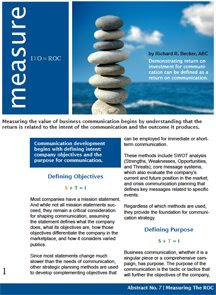
Many executives lose interest in them. Some communicators dismiss them. And a few people have called for their death.
Considering the backlash, we might even ask: What did the mission statement ever do to deserve such dissent and disinterest? Or maybe the question ought to be: What didn't it do? Or even better: What did we do to it?
What is a mission statement?
Simply defined, a mission statement and its various counterparts — purpose, vision, core values — provides a brief description of a company’s purpose and answers why the organization exists for the publics it strives to serve.
"We have chosen to specialise within the hospitality industry, by offering only experiences of exceptional quality." — Four Seasons
It also needs to be in the forefront of every communicator's mind, regardless whether the focus is advertising, internal communication, marketing, public relations, social media, etc. Why? Because if a company and its employees cannot consistently define why an organization exists, then one day it might not exist at all. Seriously? Seriously.
Best Buy: Our business strategy is to bring technology and consumers together in a retail environment that focuses on educating consumers on the features and benefits of technology and entertainment products, while maximizing overall profitability.
Circuit City: ? (One of the most looked for, but never found.)
Why don't some mission statements work?
Internet searches reveal hundreds of different reasons why mission statements don't work, ranging from underdefined and overcomplicated to underutilized and overreaching. Take your pick. But in reality, the only reason mission statements fail is the people behind them.
Either people placed too much effort into defining what a mission statement "should" do and not so much effort in what the company does do or they abandoned it all together in favor of the flavor du jour. As a result, some mission statements become overloaded with statements about diversity, empty marketing promises, and ego-driven prose. Others become dusty while the company moves on without them.
Do strong mission statements have common denominators?
Having been part of several strategic planning sessions for various companies since the early 1990s, it seems to me that "should" only consists of four letters when applied to a strategic planning process. It's a dirty word. However, despite various opinions and schools of thought, there are generally four common denominators that the strong mission statements share.
• It defines what the company does.
• It defines what the objectives are.
• It considers various publics.
• It differentiates the company.
"We will provide branded products and services of superior quality and value that improve the lives of the world's consumers, now and for generations to come." — Procter & Gamble
Why is a mission statement important to communication?
Regardless of how a communicator feels about the mission statement, it remains as part of the presentation for communication development, brand management, and measurement. Just as a mission statement and its various counterparts provide an underlying direction for the company, it provides direction for communication.
"To bring inspiration and innovation to every athlete in the world. If you have a body, you are an athlete." — Nike
It is also one of three components to consider in defining the intent of communication. As Philip Kotler once put it, the mission statement acts as an invisible hand that guides employees to work independently and yet collectively toward the same goals. It also provides a baseline of expectations that various publics will use to define their impression of the company.
While we could delve into the methods and differentiate product-oriented models vs. market-oriented models, the purpose of this post is simply to reestablish its importance in defining intent. After all, if an organization cannot communicate or reinforce why it exists, then it leaves its purpose open to interpretation and the risk of brand erosion or failure.
This doesn't mean the mission statement has to appear verbatim in all communication. Far from it. Since mission statements are measured by the experiences of customers, they can be reinforced in different forms across advertising, marketing, public relations, and social media.
For example, Four Seasons communication frequently reinforces exceptional experiences. Nike's "Just do it" campaign almost always captures inspiration. And Procter & Gamble, even though it markets multiple branded products, is still reinforced by "Touching lives, improving life" and "Everyday solutions" All three have public relations efforts that tend to follow suit. So do their community relations programs. And so does their internal communication.
In sum, the mission statement (or other definition of company purpose) is an ever-present part of communication, even as it is influenced by SWOT and other strategic planning methods (presented next week) or as specific communication tactics are developed to meet objectives. It is the presentation behind the presentation.
We help agencies, companies, organizations, and communities produce the most effective communication possible by composing powerful messages across all media. — Copywrite, Ink.
Download The Abstract: Measure: I | O = ROC
The ROC is an abstract method of measuring the value of business communication by recognizing that the return on communication — advertising, marketing, public relations, internal communication, and social media — is related to the intent of the communication and the outcome it produces. Every Monday, the ROC series explores portions of the abstract.

















